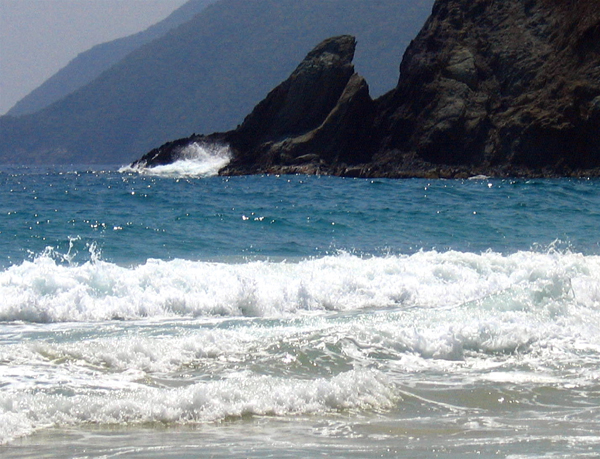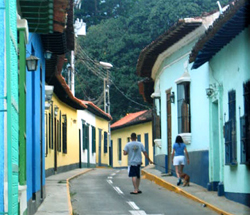CHORONI, VENEZUELA - We emerge from the heavy mist that hangs over Henri Pittier National Park into a world of vibrant greens, azure blues and bright sunshine.
The highway sign tells us we’re entering Choroní, but it looks like we’ve found paradise.
This small Spanish colonial village located on Venezuela’s Caribbean coast next to the larger town of Aragua, looks like it’s been frozen in time. Narrrow streets lined with brightly coloured posadas, shops and homes have changed little since the village was first established centuries ago. Choroní was first occupied by indigenous people and then in the early 16th century by Europeans and African slaves.
Choroni, a three-hour drive from the capital Caracas, is now Venezuela’s 21st century hotspot.
Thousands of tourists flock to this area each year to see the country’s first national park and to enjoy the seaside splendour found here. The park is famous for its birdlife and was named after Henri Pittier, a Swiss biologist, who classified over 30,000 species of plants in the park while he was here in the early 1900s.
But as remarkable as the national forest is, it’s the beach that most foreigners love about Choroni. Young people from around the world make the pilgramiage to Choroni Beach - it’s official name is Playa Grande but because of its proximity to the village, everyone refers to it as Choroni Beach - and party with the locals on beaches rung by lush mountains.

Above: The country’s rocky coastline and wild surf make it ideal for water sports.
The people here are some of the friendliest in a country full of friendly people. Its streets are safe to walk, no matter the time of day or night, and the party atmosphere that prevails here is enhanced on weekends and holidays when drummers from Choroni and neighbouring Puerto Colombia - another colonial beach village - who come together on the beaches and spice the air with native music. The impromptu sessions usually last until dawn.
The local restaurants serve up some of the tastiest dishes in the country with Mango, with only eight tables, topping our favourites list. Casabe is another highly recommended dining spot - wonderful décor - and our breakfast at Restaurante Mora (a Venezuelan-type meal called criollo which consisted of mostly fruits, yogurt and cereals) was wonderful.
All the meals served in Choroni are resonably priced and are accented with the wide range of fruits and vegetables grown in this tropical climate.
Accomodation here ranges from $20 a night guesthouses and posadas, to $100-plus a night beach resorts. Many of the origional colonial homes have been turned into posadas and they offer visitors a great chance to experience local life. Many of the posasdas have cafes attached to them and breakfast is usually included in your accommodation.
While Choroni Beach is the largest and most popular in the area, Puerto Colombia is also blessed with a remarkable shoreline featuring giant palm trees that protect the area’s delicate cocoa plantations - the area’s second largest industry after tourism. From Puerto Colombia you can take small boats to other popular beaches, chuao and cepe.
 Left: Colourful colonial homes are what make small village so appealing.
Left: Colourful colonial homes are what make small village so appealing.
Daily activities like diving and organzied hikes through the local rainforest that take you to some spectacular waterfalls and along gently flowing rivers, are all part of a trip to this part of Venezuela.
After a few days of sun and fun in Choroni, it was time for us to return to the capital along the brilliant ribbon of ashphelt that snakes through breathaking Henri Pittier National Park.
The drive reveals the best of Venezuela; its towns, coastline, rural lifestyle and an eco-system that has few equals. While the national forest is the oldest in the country - established in 1937 - it covers a relatively small area; just 1,000 square kilometres, stretching from the country’s Caribbean coast in the north to the agricultural city of Maracay in the south.
The forest features one of the most diverse animal populations in the world - monkeys, deer, tapirs, armadillos, ocelots, jaguars, puma, foxes, frogs and nearly 600 species of birds. Nearly 40 per cent of Venezuela’s bird species make the forest their home.
The drive to Maracay is just 44-kilometres but the winding, narrow road makes progress slow, which is fine because there’s much to see along this route that rises abruptly 2,436 metres to its highest point in Pico Cenizo. The southern slope of the park is not as variable as the northern side, and ends with open savannas in the foothills of the Aragua Valley.
The park is home to several rare mammal species, including the bush dog the longhaired spider monkey and several bat species. The endemic aquatic rat is one of the park’s most notable mammal species.
The memorable forest drive ends in Maracay, the most important city in Aragua State, which was established in 1701.
We take one last look at the national forest in the distance - the mist begins to shroud it from our view but never from our memory.